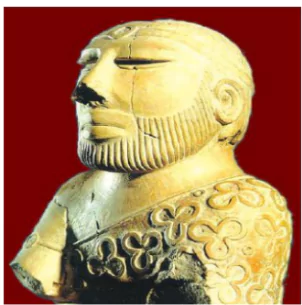Introduction
The sculptures of Indus Valley Civilization, dating back over 4,000 years, offer insights into the artistic sophistication and cultural practices of one of the world’s earliest urban societies.The first known sculptures of the Indian subcontinent were from the Indus Valley civilization made up of stone, Bronze and clay.

Stone Statues: An Overview
- Bust of a Bearded Man (Mohenjo-Daro): The statue is made up of steatite and is interpreted as a priest. It bears a close resemblance to a similar figure discovered in the Sumerian sites of Ur and Susa.
- Torso in Red Sandstone (Harappa).
- Male Dancer: It was discovered at Harappa, showing the importance of music and dance.
Enroll now for UPSC Online Course
Bronze figures: An Overview
- The bronze statues of human as well as animal figures were found, which were made using the “lost wax technique” or “Cire Perdue”.
- Four-inch high Copper Dancing Girl, in Tribhanga posture, was found at Mohenjo-Daro.
- Animal figures include a buffalo, copper dog and bird of Lothal and the bronze figure of a Bull from Kalibangan.
- Bronze sculptures of Indus Valley Civilization from Daimabad (Maharashtra) showcase unique representations, such as the Chariot driven by a human figure with sturdy bulls in the forefront.

- It refers to the use of fire-baked clay for making sculptures.
- They were made using the pinching method and had been found mostly in the sites of Gujarat and Rajasthan (Kalibanga).
- The Mother Goddess figure at Mohenjo-Daro was worshiped for fertility and prosperity.
- Other figures like that of a Bull, a pair of squirrels, a toy animal (Mohenjo-Daro), a bearded male with coiled hair, and toy carts with wheels were also found.
Enroll now for UPSC Online Classes
Conclusion
- Through their depictions of human and animal figures, as well as symbols of ritual and daily life, the architecture and sculptures of Indus Valley Civilization provide valuable clues to understanding the civilization’s beliefs, customs, and artistic achievements.
![]() April 12, 2024
April 12, 2024
![]() 1603
1603
![]() 0
0

